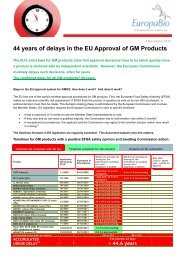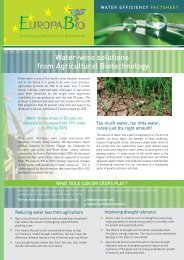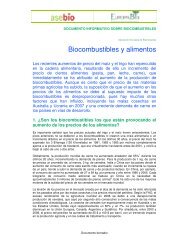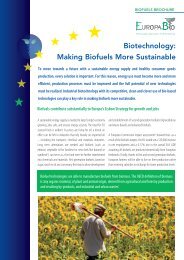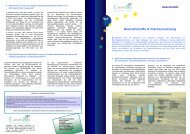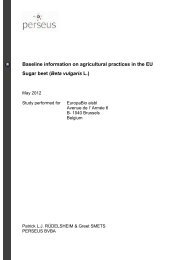GM crops: Reaping the benefits, but not in Europe - Europabio
GM crops: Reaping the benefits, but not in Europe - Europabio
GM crops: Reaping the benefits, but not in Europe - Europabio
Create successful ePaper yourself
Turn your PDF publications into a flip-book with our unique Google optimized e-Paper software.
10<br />
5. EU IMPACTS FROM TWO AVAILABLE PRODUCTS<br />
Two products approved for cultivation<br />
<strong>GM</strong> <strong>crops</strong> can only be cultivated <strong>in</strong> <strong>Europe</strong> when <strong>the</strong>y receive approval. To date, only two <strong>GM</strong> crop<br />
types have been approved for cultivation <strong>in</strong> <strong>the</strong> EU: <strong>in</strong>sect-resistant maize and, s<strong>in</strong>ce 2010, a potato<br />
for <strong>in</strong>dustrial use.<br />
Agricultural Biotechnology <strong>in</strong> <strong>Europe</strong> Plant<strong>in</strong>g figures (<strong>in</strong> ha)<br />
Country vs. Year 2006 2008 2010<br />
Spa<strong>in</strong> 53.667 79.269 76.575<br />
Portugal 1.250 4.851 4.868<br />
Czech Republic 1.290 8.380 4.830<br />
Poland 100 3.000 3.000<br />
Slovakia 300 1.900 1.248<br />
Romania 90.000 9.000 822<br />
Sweden 0 0 80<br />
Germany 950 3.173 15<br />
France 5000 0 0<br />
Total 152.557 109.573 91.438<br />
Note: The strong decreases <strong>in</strong> France and Germany can be expla<strong>in</strong>ed by political bans on MON810 maize.<br />
Romania had to stop cultivation of <strong>GM</strong> soya bean when <strong>the</strong>y jo<strong>in</strong>ed <strong>the</strong> EU <strong>in</strong> January 2007.<br />
Bt maize and <strong>the</strong> corn borer<br />
For years, <strong>in</strong>sect resistant <strong>GM</strong> maize was <strong>the</strong> only <strong>GM</strong> crop cultivated <strong>in</strong> <strong>Europe</strong>. In 2010, it was<br />
cultivated on 91,193 ha, represent<strong>in</strong>g over 99% of <strong>the</strong> land used for <strong>GM</strong> crop cultivation <strong>in</strong> <strong>the</strong> EU.<br />
This is <strong>the</strong> so-called Bt maize – a variant of maize which has been genetically altered to express<br />
a prote<strong>in</strong> from <strong>the</strong> bacterium Bacillus thur<strong>in</strong>giensis. The Bt prote<strong>in</strong> tackles <strong>the</strong> <strong>Europe</strong>an corn borer,<br />
a widespread <strong>in</strong>sect pest present <strong>in</strong> sou<strong>the</strong>rn and middle <strong>Europe</strong>. The corn borer is capable of<br />
destroy<strong>in</strong>g up to 20% of a maize crop 24 .<br />
The Spanish Bt maize experience<br />
Spa<strong>in</strong> is <strong>the</strong> country with by far <strong>the</strong> largest <strong>GM</strong> cultivation <strong>in</strong> <strong>the</strong> EU, all of it be<strong>in</strong>g Bt maize. Additional<br />
farm <strong>in</strong>come s<strong>in</strong>ce <strong>in</strong>troduction of <strong>the</strong> technology <strong>in</strong> Spa<strong>in</strong> has been calculated at $93.5 million 25 .<br />
Average additional earn<strong>in</strong>gs <strong>in</strong> Spa<strong>in</strong> were ¤186/ha 26 . The average yield <strong>in</strong>crease is 6.3% and depends<br />
heavily on <strong>the</strong> <strong>in</strong>tensity of pest <strong>in</strong>festation (with low <strong>in</strong>festation, yield <strong>in</strong>creases of up to 1%, with high<br />
<strong>in</strong>festation, yield <strong>in</strong>creases of 10 to 20% have been reported) 27 .<br />
In a recent survey, 93% of Spanish farmers who planted Bt maize <strong>in</strong> 2010 said <strong>the</strong>y would do so <strong>in</strong> <strong>the</strong><br />
next season 28 . In Spa<strong>in</strong>, <strong>GM</strong> adoption is <strong>not</strong> statistically related to farm size 29 and <strong>the</strong>re was no impact on<br />
<strong>the</strong> amount of farm labour employed. Yield ga<strong>in</strong>s on Bt maize translated directly <strong>in</strong>to revenues <strong>in</strong>crease,<br />
as <strong>the</strong>re is no difference <strong>in</strong> <strong>the</strong> crop price paid to Bt or conventional maize farmers 30 . The economic<br />
welfare result<strong>in</strong>g from adoption of Bt maize <strong>in</strong> Spa<strong>in</strong> is shared between farmers and seed companies,<br />
<strong>in</strong>clud<strong>in</strong>g <strong>the</strong> seed developer, seed producers and seed distri<strong>but</strong>ors. The largest share of welfare<br />
(74.4% on average) went to Bt maize farmers and <strong>the</strong> rest to <strong>the</strong> seed companies (25.6% on average) 31 .<br />
Source<br />
ISAAA



